CHAPTER 5
LOWER BROADWAY— TRINITY CHURCH TO ST. PAUL’S CHAPEL. THE WORLD TRADE CENTER
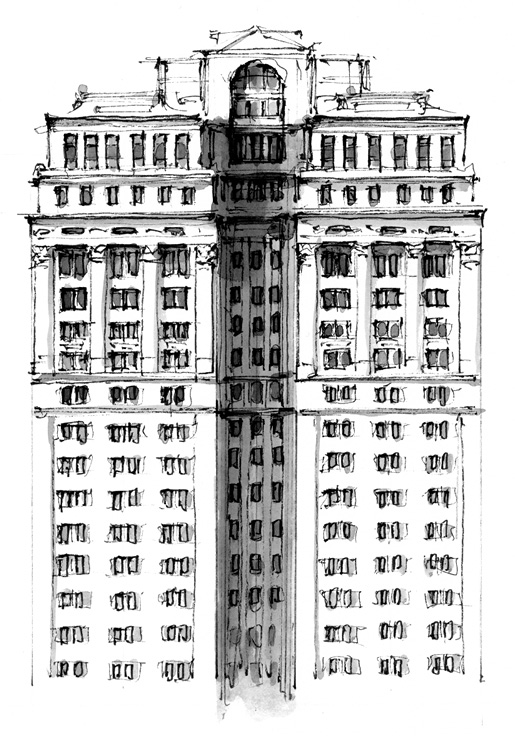
The Equitable Building
No. 120 Broadway
THE EQUITABLE BUILDING, which stands at No. 120 Broadway, is a most significant building in the story of modern New York’s architectural development, for this was the building that provoked the city’s zoning laws, which for 50 years defined the shape of New York’s skyscrapers.
When completed in 1915, the Equitable Building was the LARGEST OFFICE BLOCK IN THE WORLD, the HEAVIEST STRUCTURE ON EARTH, and boasted MORE ELEVATORS THAN ANY OTHER BUILDING IN THE WORLD. Consisting of two massive blocks connected by a middle wing, and shaped like an “H” when seen from above, the building can accommodate 12,000 people and provides 1,200,000 sq ft (111,500 sq m) of floor space, some 30 times the size of the plot on which it stands. It rises straight up to a height of 538 ft (164 m) and casts a seven-acre (2.8 ha) shadow across the city, blotting out the sun completely from the streets below and from the first 20 stories of the neighboring buildings.
New Yorkers were mightily worried that if many more buildings like this were put up, then the streets of Manhattan would become dark ravines, cold and sunless, so in 1916 the city adopted a zoning resolution that required all new buildings to incorporate setbacks as they rose in height, allowing sunlight to reach through to street level. The measure had the effect of inspiring some of the world’s most admired and distinctive skyscrapers, such as the Chrysler Building and the Empire State Building.
Equitable Life Assurance Building
The predecessor of the Equitable Building at No. 120 Broadway was the EQUITABLE LIFE ASSURANCE BUILDING, 130 ft (40 m) high and THE TALLEST OFFICE BLOCK IN THE WORLD when it was built in 1870. It was also THE FIRST OFFICE BUILDING IN THE WORLD TO FEATURE PASSENGER ELEVATORS, one reason why it was sometimes referred to as the “WORLD’S FIRST SKYSCRAPER.” Tourists flocked there to ride the elevators and take in the view from the roof. Although advertised as fireproof, the Equitable Life Assurance Building burned down in January 1912, in a winter so cold that the water from the fire trucks froze onto the ruins of the structure, turning it into a giant ice sculpture.
Luck and Joie de Vivre
The bright red cube precariously balanced on the plaza outside the HSBC building at No. 140 Broadway seems to symbolize the roll of the dice, or luck. It was created in 1968 by the Japanese-American artist ISAMU NOGUCHI and certainly brightens up this part of Broadway.
Immediately across Broadway, in ZUCCOTTI PARK, is the equally red, 70 ft (21 m) high abstract expressionist sculpture JOIE DE VIVRE, by MARK DI SUVERO. Zuccotti Park used to be called Liberty Plaza Park, but it was renamed and revamped after the September 11 bombings.
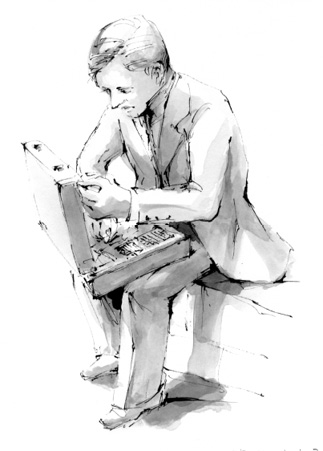
One resident of Zuccotti Park who was unmoved by the death and destruction that rained down around him on that day is DOUBLE CHECK, a bronze stockbroker who was found afterward still sitting on his park bench checking through his paperwork amid the dust and debris. Double Check, created by J. SEWARD JOHNSON JR. and placed here in 1982, has become a much cherished emblem of New York’s endurance and spirit.
First Movie Show
It seems fitting that THE FIRST MOVING PICTURE EVER TO BE SHOWN ON A SCREEN TO A PAYING AUDIENCE was shown on Broadway, home of showbiz in all its many forms. The movie was a four-minute film of a boxing match between “Battling” Charles Barnett and an Australian boxer named Albert Griffiths, known as “Young Griffo,” filmed on the roof of Madison Square Garden by WOODVILLE LATHAM. The date of the showing was May 20, 1895, the place a storefront at No. 153 Broadway. Alas, being the site of this moment in movie history was not enough to save No. 153 Broadway from being obliterated, along with all the other shops in the row, when Singer Sewing Machines wanted to put up their new headquarters on this exact spot.
Singer and Steel
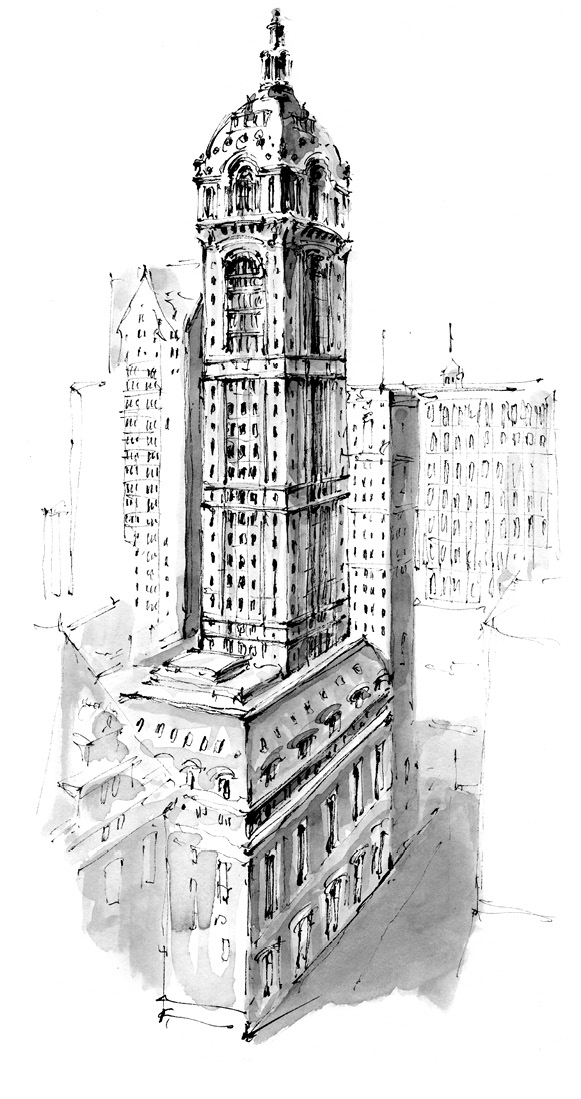
The fabulous SINGER BUILDING, 612 ft (186 m) high and easily THE TALLEST BUILDING IN THE WORLD when completed in 1908, was designed by Ernest Flagg as the headquarters of the Singer Manufacturing Company, founded in 1851 by Isaac Singer, whose wife was the model for the Statue of Liberty. The actual offices were accommodated in the lower block of 12 stories while the stunning, 65 ft square (6 sq m) redbrick and bluestone beaux arts tower, with its distinctive bulbous top, recognizable from miles away, served largely as an enormous advertisement for Singer Sewing Machines.
On moving its headquarters to Rockefeller Center in 1961, Singer sold the tower to a developer who was hoping to tempt the New York Stock Exchange to relocate there, but due to the shape of the building there was too little office space and so it was sold to U.S. Steel, who dismantled the whole structure and replaced it with the 743 ft (226 m) high skyscraper we see there today, One Liberty Plaza.
When the Singer Building was taken down in 1967 it became THE TALLEST BUILDING EVER TO BE LEGITIMATELY DEMOLISHED. With hindsight its disappearance is regarded as one of New York’s greatest architectural losses.
Downtime
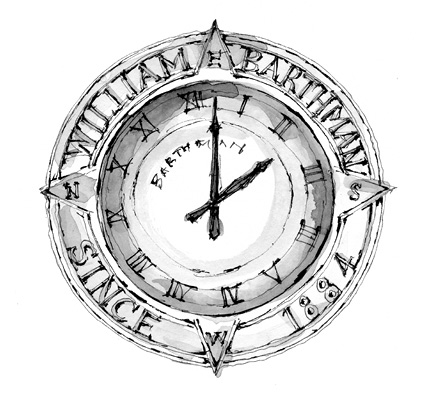
Embedded in the sidewalk on the north-east corner of Broadway and Maiden Lane is one of Manhattan’s most unexpected treats, a large clock with roman numerals set in a brass surround inscribed with the words WILLIAM BARTHMAN SINCE 1884. The clock was put there in 1899 as a novel form of advertisement by WILLIAM BARTHMAN, a German immigrant who set up his jewelry shop at No. 174 Broadway in 1884, when this area was at the heart of New York’s jewelry trade.
Known as the “Downtown Tiffany,” Barthman’s is the OLDEST JEWELER IN NEW YORK and was for a long time the only jeweler left in the Financial District. Over the years it has been patronized by Vanderbilts and Guggenheims as well as such luminaries as J. P. Morgan and Lillie Langtry, actress and mistress of Edward VII.
The Barthman Clock can only be accessed from vaults below the pavement, and in 1946 the NYPD estimated that every day 51,000 people stepped over it or trod on it between the hours of 11 a.m. and 2 p.m. But how many of them know it is there?
In 1911 a runaway horse smashed into the Barthman shop window, scattering jewels all across Broadway, but the clock remained undamaged. Ninety years later the shop window was shattered once again, this time by debris from the collapse of the Twin Towers, but still the clock ticked on.
In 2006 William Barthman moved next door to bigger premises at No. 176 Broadway.
Former AT&T Building
The facade of the former AT&T BUILDING, constructed for American Telephone and Telegraph in 1923 at No. 195 Broadway, boasts MORE CLASSICAL COLUMNS THAN ANY OTHER FACADE IN THE WORLD, 198 of them in all, made from Vermont granite. The remarkable lobby is graced with columns too, 50 Doric columns made of marble, with the result that the interior of No. 195 Broadway boasts MORE MARBLE THAN ANY OTHER BUILDING IN NEW YORK.
On January 25, 1915, ALEXANDER GRAHAM BELL, the inventor of the telephone, made the FIRST TRANSCONTINENTAL TELEPHONE CALL from an office on this location, which at that time had the address No. 15 Dey Street —Dey Street runs west off Broadway here. The call was to his assistant, THOMAS WATSON, in San Francisco, and Bell replicated his words from when he made the world’s very first telephone call in 1876, “Mr. Watson, come here, I want you,” to which Watson replied, “It would take me a week now.”
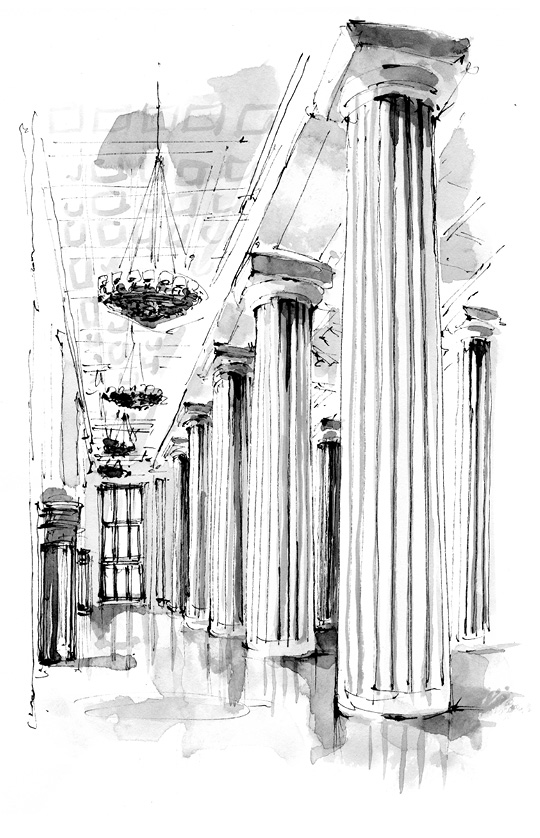
On January 7, 1927, WALTER S. GIFFORD, president of AT&T, placed the WORLD’S FIRST TRANSATLANTIC TELEPHONE CALL from No. 195 Broadway to Sir Evelyn P. Murray, secretary of the General Post Office of Great Britain in London.
On April 7, 1927, Gifford placed the WORLD’S FIRST “PICTUREPHONE” CALL from No. 195 Broadway to the secretary of commerce, Herbert Hoover, who was in Washington. The listeners in New York could see, as well as hear, Hoover in Washington.
Time Ball
Before it was AT&T, the site at No. 195 Broadway was occupied by the telegraph company WESTERN UNION, whose headquarters, built in 1875, was crowned with a clock tower 230 ft (70 m) high. It was one of the tallest buildings in New York at the time and from 1877 a Time Ball, prompted by a signal from the National Observatory in Washington, D.C., was dropped from the top of the clock tower at exactly noon every day, to serve as a chronometer for the ships in the harbor. Between 1883 and 1912 the Time Ball was also used as the starting point for U.S. Standard Railway Time.
St. Paul’s Chapel
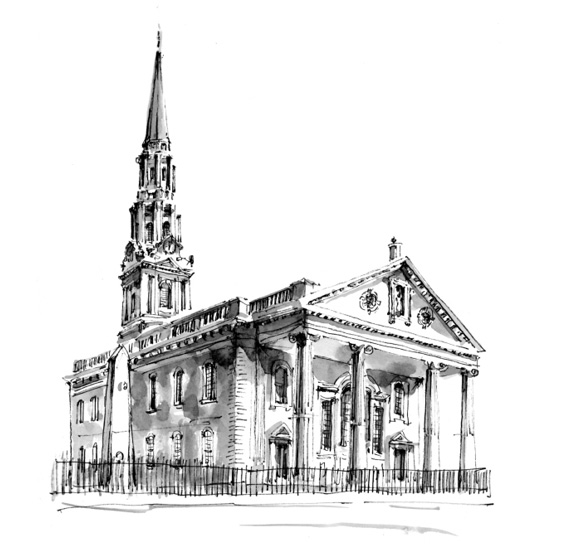
ST. PAUL’S CHAPEL comes as quite a surprise. Standing four-square and Georgian among the towering neo- classical and art deco office blocks of downtown, it appears almost too perfect to be real. It was built in 1764 as a chapel of ease for parishioners of Trinity who were unable to reach the main church. St. Paul’s Chapel was modeled on St. Martin-in-the Fields in London—and indeed, like St. Martin, St. Paul’s was surrounded by fields when it was built.
The chapel survived the fire of 1776, which destroyed the original Trinity Church, partly because it was farther from the heart of the blaze and also because firefighters positioned themselves on the flat roof wielding buckets of water to keep the flames at bay.
St. Paul’s Chapel is now THE OLDEST BUILDING IN MANHATTAN IN CONTINUOUS USE and THE ONLY SURVIVING CHURCH FROM NEW YORK’S COLONIAL DAYS.
Box Pew
The interior of St. Paul’s Chapel is very little changed from the April day in 1789 when George Washington attended a service of thanksgiving here after his inauguration as the 1st president of the United States. Since Trinity Church was being rebuilt at the time, Washington continued to worship at St. Paul’s Chapel until he moved to Philadelphia in 1790. Outside the chapel there is a slightly misleading sign exhorting you to go in and “See George Washington’s Pew”—alas, the splendid box pew inside the chapel is only a replica of the one Washington sat in, and you cannot therefore experience the touch of the very same wood grain that the 1st president touched.
Wild Turkey
Above the pew hangs THE FIRST KNOWN COLOR REPRESENTATION OF THE GREAT SEAL OF THE UNITED STATES, an original oil painting done in 1785. The eagle in the painting more closely resembles a wild turkey than an eagle, which suggests that Benjamin Franklin was involved with the design of this particular seal—he was a strong advocate for the adoption of the wild turkey as America’s national bird rather than the eagle.
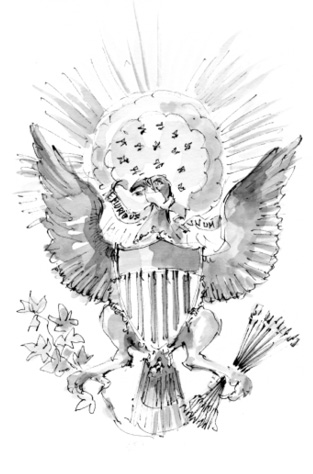
Across the chapel from Washington’s pew is the GOVERNOR’S PEW, where GEORGE CLINTON, THE FIRST GOVERNOR OF THE STATE OF NEW YORK, sat when he attended the chapel.
Others who have worshipped at St. Paul’s Chapel over the years are PRINCE WILLIAM (later King William IV), who attended while he was stationed in New York as a midshipman during the Revolution; LORD CORNWALLIS, the British commander who surrendered to American troops at the Battle of Yorktown in 1780; and three U.S. presidents, Grover Cleveland, Benjamin Harrison, and George W. Bush.
Note the coronet with Prince of Wales feathers on the canopy of the pulpit, one of the few royal symbols in New York to survive the Revolution.
Sanctuary
St. Paul’s Chapel stands just across the street from the site of the World Trade Center, but emerged miraculously unscathed from the collapse of the Twin Towers on 9/11, protected as it was by a giant sycamore tree that had been growing in the churchyard for nearly a century.
In 2005 artist Steve Tobin temporarily moved the stump of “the tree that saved St. Paul’s” from the churchyard in order to create a huge bronze sculpture of the roots. The sculpture, called the TRINITY ROOT, was placed beside Trinity Church, while the stump was returned to St. Paul’s churchyard, where it stands as a defiant memorial to that dreadful day.
In the aftermath of the terrorist attacks, St. Paul’s Chapel acted as a sanctuary for those seeking shelter from the destruction, and in the following months served as a working center for the recovery operation, filled day and night with weary firefighters, construction workers, police officers, and volunteers. The chapel now houses a permanent display of photographs and exhibits about their remarkable rescue efforts.
A WALK AROUND THE WORLD TRADE CENTER
Start point: St. Paul’s Chapel
World Trade Center
Just north of St. Paul’s Chapel turn left on to Vesey Street and walk to the new World Trade Center site.
September 11, 2011
At 8.46 a.m. on the morning of September 11, 2001, the hijacked American Airlines Flight 11, originally bound for Los Angeles out of Boston, flew into the 93rd floor of the North Tower, 1 World Trade Center (WTC). Eighteen minutes later United Flight 175, also bound for Los Angeles out of Boston, hit the South Tower, 2 WTC, between the 77th and 85th floors. At 9.59 a.m. the South Tower collapsed, followed by the North Tower 29 minutes later.
3 WTC, a Marriott Hotel, was completely destroyed as the Twin Towers fell, and the other three WTC towers were so badly damaged they were later demolished. 7 WTC, located outside the 16-acre (6.5 ha) WTC site, finally came down at 5.20 p.m. that day. Two other buildings, the Deutsche Bank Building on Liberty Street and the Fiterman Hall on West Broadway, also suffered such severe damage that they were eventually pulled down.
Two other planes were hijacked on that day. One was flown into the Pentagon, killing 184 people, while the passengers on United Flight 93 valiantly tried to overpower their hijackers, forcing their plane to crash in a field in Pennsylvania, killing all 40 people on board.
The final death toll may never be known, but between 2,750 and 3,000 people died, either on that day or as a result of the attacks, a heavier loss of life than during the entire Revolutionary War.
National September 11 Memorial and Museum
The WORLD TRADE CENTER site has been substantially rebuilt since the terrorist attacks on September 11, 2001, with five new skyscrapers and the NATIONAL SEPTEMBER 11 Memorial and Museum, which replaces the Twin Towers.
The whole area is landscaped with trees, including the “SURVIVOR TREE,” a Callery pear tree that was rescued from the rubble, revived, and replanted at the memorial site. Within the actual square footprints of the towers are two reflective pools with THE LARGEST MAN-MADE WATERFALLS IN AMERICA cascading down the sides of the parapets. The names of the victims of the terrorist attacks are inscribed on bronze plates attached to the parapet walls. Underground there is a museum dedicated to documenting and explaining the events of that day and its repercussions, with displays, exhibits, and photographs.
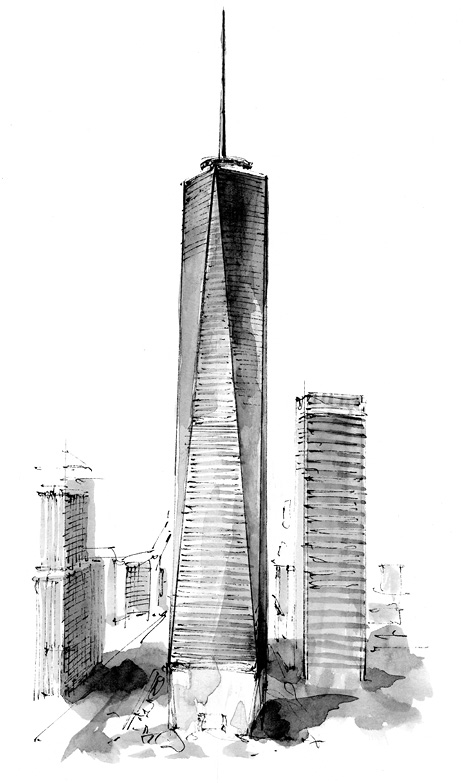
The tallest and most spectacular of the new World Trade Center towers is ONE WORLD TRADE CENTER, better known as the FREEDOM TOWER, which stands at the northwest corner of the site. The roof of the tower is 1,385 ft (422 m) high, the exact height of the Twin Towers, while the top of the antenna reaches a symbolic 1,776 ft (541 m), making One World Trade Center THE TALLEST BUILDING IN NEW YORK, in place of the Empire State Building.
Battery Park City
Having walked around the site, leave the World Trade Center by the pedestrian bridge over West Street at the northwest corner and walk west along Vesey Street toward the Hudson. You are now in BATTERY PARK CITY, a commercial and residential complex built during the 1980s on 92 acres (37 ha) of landfill, collected largely from the excavations for the original World Trade Center. The neighborhood was badly affected by the 9/11 attacks, and most of the residents were required to leave their homes for some years while toxins and smoke pollutants were removed, but by 2009 the area was fully recovered and is now thriving.
Irish Hunger Memorial
At the end of Vesey Street is the IRISH HUNGER MEMORIAL, dedicated in 2002, which commemorates the Irish Famine of 1845 to 1852. The memorial resembles an Irish hillside and is constructed from materials brought from the west coast of Ireland, including stones from every Irish county and the ruins of an authentic 19th-century Irish cottage. A path ascends to the top of the hill, from where there are splendid views across the Hudson and the harbor.
World Financial Center
Now head to the river, turn left (south) and walk along the waterfront to the WORLD FINANCIAL CENTER, designed by Cesar Pelli and built between 1985 and 1988. There are four office towers that serve as headquarters for a number of the world’s leading financial companies, such as Merrill Lynch, Nomura, Commerzbank, and American Express.
The towers are grouped about the huge glass atrium of the WINTER GARDEN, a vast public space for concerts and exhibitions, flanked by shops and restaurants and opening out onto a piazza and marina. Sixteen 40 ft (12 m) high Washingtonia palm trees create a spectacular “palm court” where you can sit on the sweeping white marble staircase and listen to live music while the sun dapples through the trees and sparkles on the water outside. One of New York’s great experiences.
All 2,000 panes of glass in the atrium were blown out by the terrorist attacks on 9/11 and had to be replaced, but the Winter Garden was swiftly repaired and reopened to the public in 2002.
Museum of Jewish Heritage
From the World Financial Center continue south along the river walk, enjoying the unobstructed view of the Statue of Liberty, go past South Cove and on to the MUSEUM OF JEWISH HERITAGE, housed in a distinctive hexagonal granite building with a stepped roof. The museum, which opened in 1997, is designed as a living memorial to the Holocaust, and the six sides of the building remember the six million Jews killed during the Holocaust, as well as the six points of the Star of David. The museum inside is organized around three themes on three floors, “Jewish Life a Century Ago,” “The War Against the Jews,” and “Jewish Renewal.”
Skyscraper Museum
Across Battery Place, adjacent to the Ritz Carlton Hotel, at No. 39, is the SKYSCRAPER MUSEUM, opened in 1997 and THE ONLY MUSEUM OF ITS KIND IN THE WORLD. The museum is devoted to the study of high-rise buildings around the world with particular focus on their role in New York’s architectural heritage.
New York’s Skyscrapers
NEW YORK HAS MORE SKYSCRAPERS THAN ANY OTHER CITY ON THE EARTH except Hong Kong. Although there is no official definition of a skyscraper, New York possessed at least two buildings, both on Broadway and both now gone, that were able to stake a reasonable claim to being THE WORLD’S FIRST SKYSCRAPER, the Equitable Life Assurance Building at No. 120 Broadway (see page 56) and the Tower Building at No. 50 Broadway (see page 39).
New York’s World Beaters
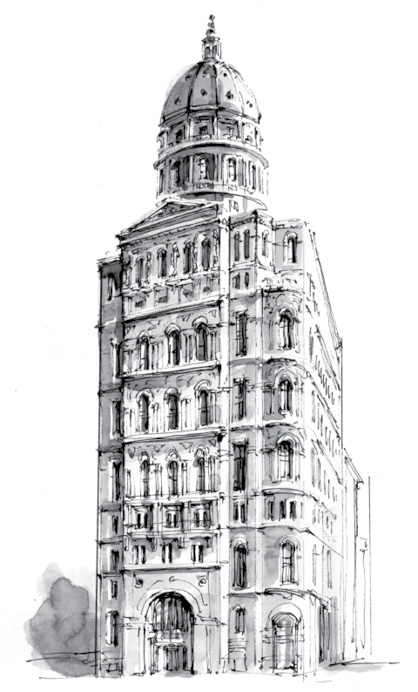
In 1890 the NEW YORK WORLD BUILDING on Park Row reached a height of 308 ft (94 m), to become the tallest skyscraper in the world. Since then New York has been able to boast more of the world’s tallest buildings than any other city.
New York’s Matchless Array of Tallest Nonreligious Buildings in the World:
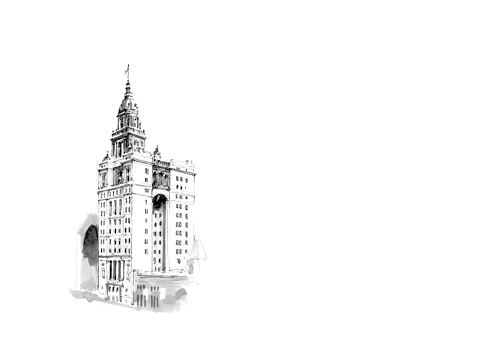
MANHATTAN LIFE INSURANCE BUILDING, 66 Broadway. Height 330 ft (100 m). Tallest skyscraper in the world, 1894–95. Demolished 1963.
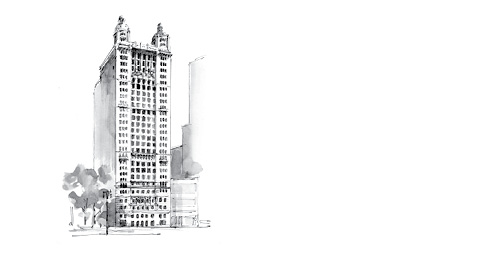
PARK ROW BUILDING, 15 Park Row. Height 390 ft (119 m). Tallest skyscraper in the world, 1899–1901. Now commercial offices and rental apartments.
In 1901 PHILADELPHIA CITY HALL became the first building in the world to top the 530 ft (162 m) high spire of Ulm Minster in Germany, which had, since 1890, been the tallest building in the world. Thereafter New York’s world beaters could genuinely use the title tallest building in the world. The first to do so was the . . .
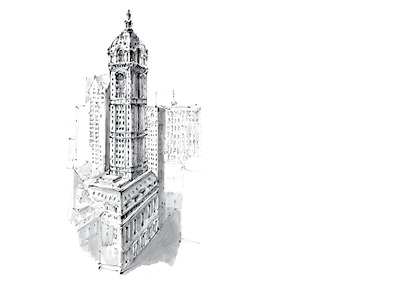
SINGER BUILDING, 149 Broadway (Now 1 Liberty Plaza). Height 612 ft (187 m). Tallest building in the world, 1908–9. Demolished 1963.
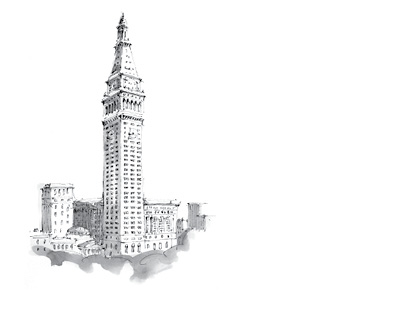
METROPOLITAN LIFE TOWER, 1 Madison Avenue. Height 700 ft (213 m). Tallest building in the world, 1909–13. Now a hotel.
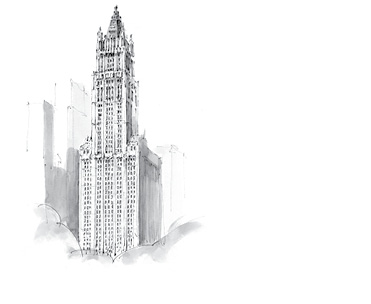
WOOLWORTH BUILDING, 233 Broadway. Height 791 ft (241 m). Tallest building in the world, 1913–30. Offices and luxury apartments.
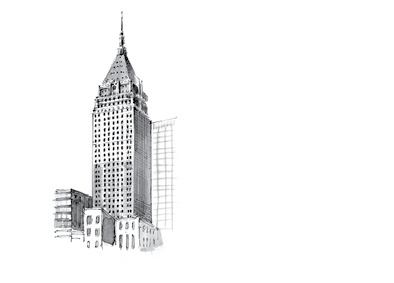
BANK OF MANHATTAN TRUST BUILDING, 40 Wall Street. Height 927 ft (283 m). Tallest building in the world, 1930. Now the Trump Building, commercial offices.
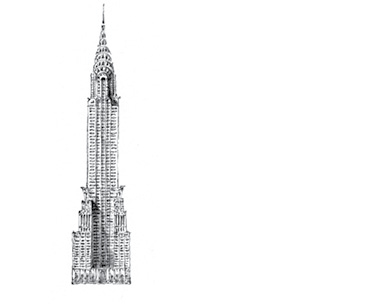
CHRYSLER BUILDING, Lexington Avenue. Height 1,050 ft (320 m). Tallest building in the world, 1930–31. When completed was the tallest structure ever built. Now commercial offices.
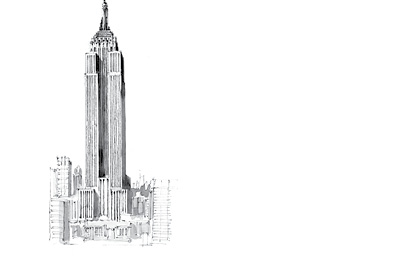
EMPIRE STATE BUILDING, 350 Fifth Avenue. Height 1,250 ft (381 m). Tallest building in the world, 1931–72 (longest period of any tallest building). Now offices and a tourist attraction.
1 World Trade Center. Height 1,368 ft (417 m). Tallest building in the world, 1972–74. Destroyed by terrorist attack in 2001.
Well, I never 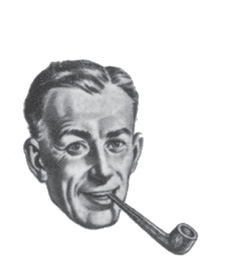 knew this
knew this
about
LOWER BROADWAY—TRINITY CHURCH TO ST. PAUL’S CHAPEL. THE WORLD TRADE CENTER
VESEY STREET, which runs off Broadway north of St. Paul’s Chapel, is named after the FIRST RECTOR OF TRINITY, WILLIAM VESEY.
The Equitable Building at No. 120 Broadway was THE FIRST OFFICE BLOCK IN NEW YORK TO HAVE ITS CORNERSTONE LAID BY THE MAYOR OF NEW YORK.
MAIDEN LANE, which runs east off Broadway near Liberty Plaza, follows the course of a freshwater stream that used to run into the East River. In the 17th century, before the area was built up, Dutch maidens used the stream for washing their laundry, hence the name of the lane. A little way down Maiden Lane, at No. 57, is a plaque commemorating the fact that THOMAS JEFFERSON, 3rd president of the United States, resided here while serving as THE FIRST U.S. SECRETARY OF STATE in 1790. Jefferson rented “a mean house in Maiden Lane” from Robert Bruce, a grocer, for “100 pounds per year.”
Under the classical portico at the east end of St. Paul’s Chapel, looking out onto Broadway, there is a large monument to AMERICA’S FIRST HERO, GENERAL RICHARD MONTGOMERY. The monument, which was put up under the orders of Congress on January 25, 1776, was THE FIRST AMERICAN MILITARY MONUMENT EVER ERECTED. In 1775 Montgomery had joined the Continental army as a brigadier-general and led an American invasion force into Canada, capturing two forts and the town of Montreal. In December that year he was killed while leading an assault on Quebec, cut down by musket fire with 11 of his men, THE FIRST OFFICER TO DIE IN THE AMERICAN REVOLUTION.
The nearest fire station to the World Trade Center is ENGINE LADDER CO. 10 on Liberty Street, on the south side of the site. A plaque on the wall of the station commemorates the five firefighters from the company who died on 9/11, while along the Greenwich Street wall is a 55 ft (17 m) long bronze sculpture dedicated to all the 343 firefighters who died that day.
The lobby of 3 World Financial Center, the AMERICAN EXPRESS TOWER, is decorated with ONE OF THE LARGEST CYCLES OF MURALS IN THE WORLD, the 318 ft (97 m) HARBORS OF THE WORLD painted by CRAIG MCPHERSON over five years from 1987 to 1992. Represented are Venice, Istanbul, Hong Kong, Sydney, Rio de Janeiro, and, of course, New York, considered to be the finest natural harbor of them all.